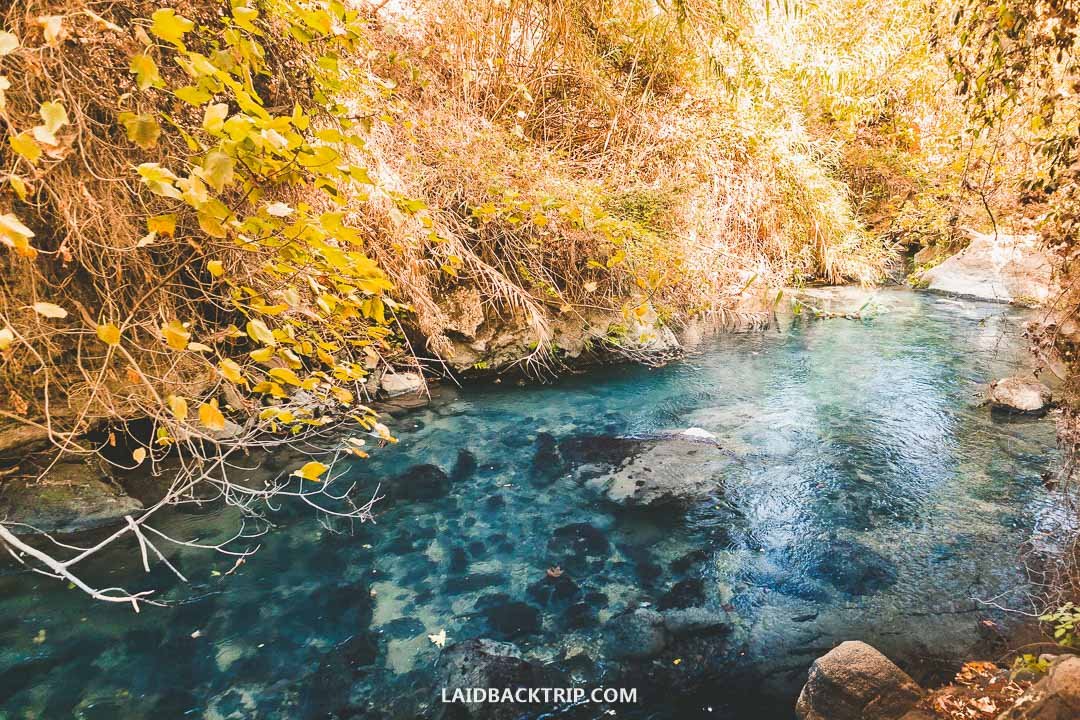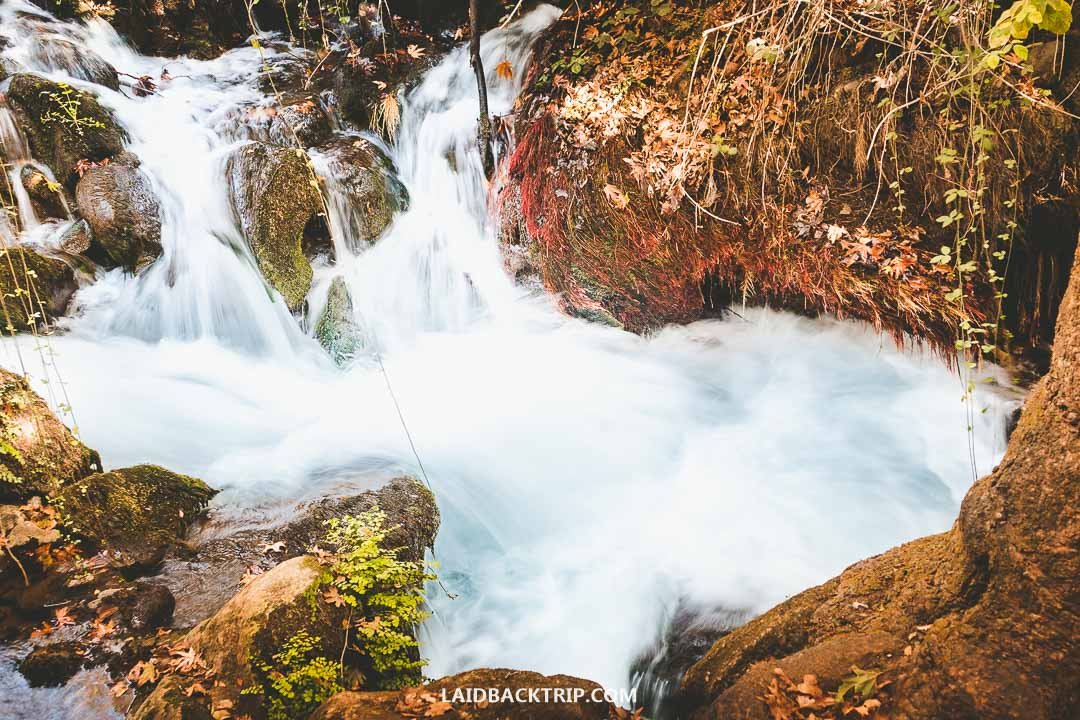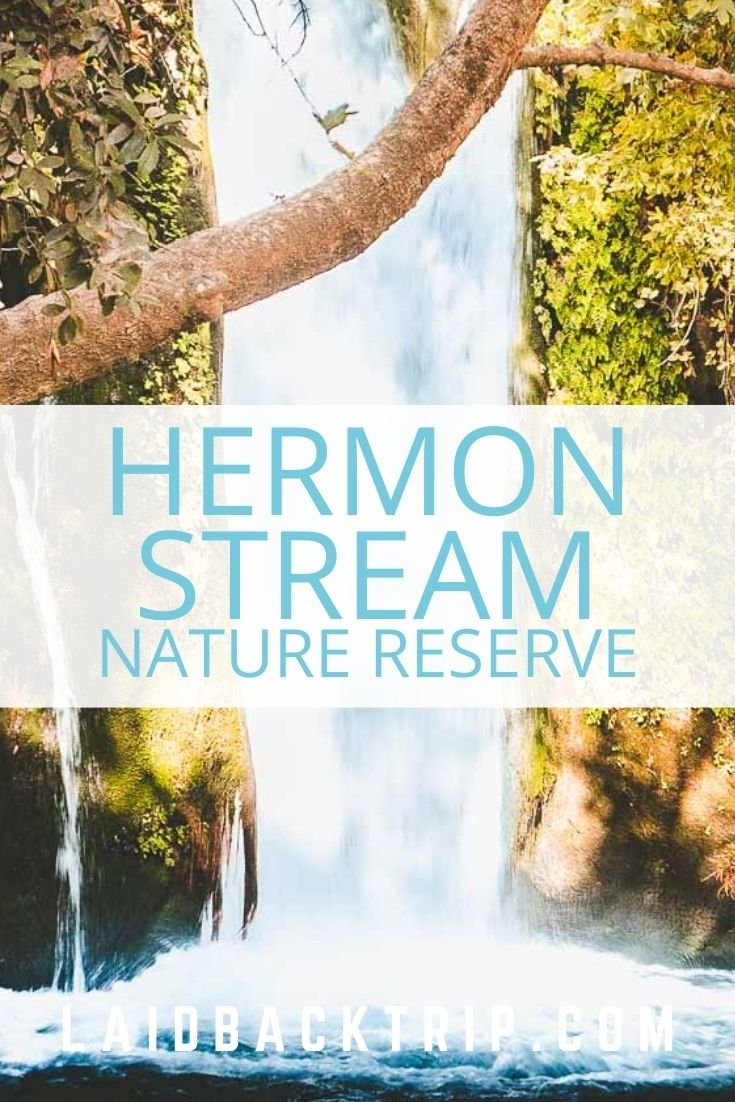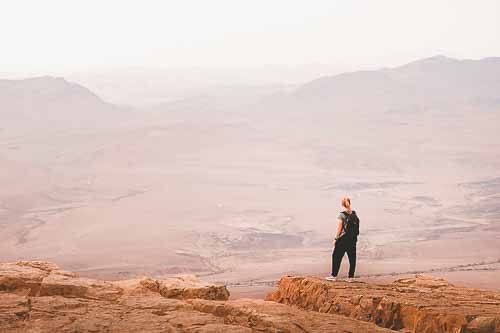A Guide to Hermon Stream (Banias) Nature Reserve, Israel
Read our travel guide on Hermon Stream Nature Reserve in Israel (also known as Banias Falls and Springs Park). Includes helpful tips on what to see and do while there, what to expect, how to get, entrance fee, or opening hours.
Hermon Stream Nature Reserve in Northern Israel is one of the less-visited places by international tourists.
And if you want to experience the Holy Land to its full potential, then this charming nature reserve shouldn't be missing from your Israel itinerary.
Indeed, one of the best reasons to visit northern Israel is to see how incredibly diverse this relatively small country really is.
The lush scenery of Hermon Stream Nature Reserve surrounded by the mountains is so different from the arid places such as Ein Bokek in the Dead Sea or Makhtesh Ramon in the Negev Desert that you can find in the south of the country.
Add a beautiful waterfall, a tributary stream that feeds the Jordan River (together with Snir Stream and Dan River), and some ancient ruins, and you get a mix of history and nature that's hard to resist.
So here's everything you need to know about Hermon Stream Nature Reserve before you go.
Things to Know Before You Go
One of the essential things to know about Hermon Stream is that the nature reserve consists of two sites.
One of them is called Hermon Stream (Banias) Nature Reserve – Waterfall and Hanging Trail Area.
The other is known as Hermon Stream (Banias) Nature Reserve – Springs Area.
The southwest waterfall section features nice hiking paths, a suspended trail, and Banias Falls, while the northeast springs part is an archaeological site with ancient ruins and, not surprisingly, springs.
Each site has its own parking lot, so you can drive between them if you want to save some time or don't want to walk.
However, hiking the approximately 2-kilometer trail between these sites might be a better alternative for those who want to stay active.
The best part is that one entry fee covers both sites.
By the way, Banias is an Arabic (misspelled) name of Paneus, which refers to the Greek God of forests and shepherds, Pan.
And yes, Banias and Hermon Stream refers to the same site.
How Much Time Do I Need
Hermon Stream Nature Reserve is a fairly large area consisting of two main sites.
Therefore, be prepared to easily spend three to four hours here, especially if you opt for walking between the areas.
Unfortunately, we didn't have enough time to see both sites, so we focused on the nature side of the reserve and left the ruins for some other day.
The idea was to see the Nimrod Fortress and, if time allowed, also stop at the Hermon Stream to see the falls.
It worked out as initially planned, but with no spare time left for the east part of the reserve.
It reminded us of a similar dilemma we faced later on in Ein Gedi, but that's the way traveling works.
It's impossible to see it all. We had embraced this philosophy years ago, and it's one of the best travel tips we can give you.
What to See and Do
As mentioned earlier, Hermon Stream Nature Reserve is a place where history meets nature.
While the waterfalls, the stream, and ancient structures might steal the show, don't forget to look around.
You might see vegetation consisting of plane trees, Syrian ashes, willows, or cliff vegetation.
And also the animal world with Syrian rock hyraxes, rock doves, kestrels, or various species of fish.
This area is also home to nocturnal animals such as wild boars, beech martens, or golden jackals (which you won't probably see).
By the way, if you're looking for a family-friendly attraction in Northern Israel, Hermon Stream Nature Reserve might be the place to go.
The entire area was buzzing with families with kids, unlike the Nimrod Fortress, which we've visited a few hours later.
Of course, it might have been just the timing of the visit as we arrived in the fortress late in the afternoon.
So, here are some of the best stops in the Hermon Stream Nature Reserve.
Hiking Trails
Hermon Stream Nature Reserve has four main hiking trails, so don't forget to grab the official brochure that contains the map and detailed instructions.
It seems that the suggested way of exploring the Hermon Stream starts at Banias Springs rather than Banias Falls.
In reality, it's not that important where you actually start, but we will follow the suggested itinerary to make things easier.
The trails in Banias Nature Reserve are easy, at least compared to Snake Path to Masada or trails in Timna Park.
Banias Springs Trailhead
We start at Banias Springs. The first part of the area has a trail with no color.
The reason is that it goes directly from the parking lot to the area featuring the Temple of Pan and Pan's Cave, Remnant from Herod's Time, Roman Bridge, and ends at Matroof Flour Mill.
Once you arrive here, you can choose from three different marked routes (although they all technically start at the parking lot).
It's a bit confusing, but you'll quickly see where you need to go once you're there.
Trail 1 - 45 minutes
This easy trail marked in yellow visits the destroyed Syrian Bridge, Mamluk Gate, or Crusader Wall.
Trail 2 - 45 minutes
The purple trail visits the Underground Passages, Lookout platform, Palace of Agrippa II, Synagogue, and Cardo.
Trail 3 - 90 minutes
Blue trail connects Banias Springs with Banias Falls, and you will have a chance to see Umm Rai Flour Mill, Waterfall Lookout, Banias Waterfall.
Keep in mind that this is an in-and-out trail, meaning that you will need to retrace your steps to return to your car.
Trail 4 - 45 minutes
If you've arrived in Banias Falls first, then this is your starting trail.
The red route is a lovely loop trail that will take you to the Suspended Trail, Banias Waterfall, and back.
Banias Springs
The ancient history of Banias Falls reaches back to the 4th century BCE.
After Alexander the Great conquered this region in 332 BCE, Paneon, a Greek temple dedicated to the god Pan, was constructed near the year-round spring.
When the Romans arrived here in the first century BCE, Herod the Great built a temple close to the springs.
After his death, Paneas became the capital city of his son's kingdom called Caesarea Philipi. The city flourished and prospered during the reign of Agrippa II; a temple and several palaces were built.
According to Christian tradition, Jesus gave Peter the keys to heaven here in Caesarea Philipi, as found in the Gospel of Matthew.
Then the Byzantines arrived, Muslims, Jews, Crusaders, Mamluks, and even Bedouins.
All the history comes together in Banias Springs, and today you can still see some of the ancient structures (as mentioned earlier) here.
Unfortunately, there is not that much left after so many centuries have passed, at least when compared to places such as Masada, Beit Shean, or Avdat.
So you will need to use quite some imagination or a talkative guide.
From here, it's either a 4-minute drive or a 30-minute walk to Banias Springs Park.
Banias Falls Park
One of the biggest waterfalls in Israel, Banias Falls, is flowing and roaring year-round.
It's very different from the waterfalls we had a chance to see in Ein Avdat or Ein Gedi in Israel's southern parts.
Banias Waterfall is 10 meters high and quite powerful, depending on the time of the year you arrive there.
So if you imagine the Holy Land as an arid dry country that doesn't have waterfalls, then the Banias Falls will make you reevaluate your views.
On the other hand, don't expect to find here Dettifoss to avoid disappointment.
Make sure to hike the entire loop, as you'll have a chance to enjoy the 100-meter Suspended Trail, which hangs above a charming gorge and gets you closer to the action.
The trail will eventually take you to the waterfall, which you can see from the bottom, or you can also cross the stream and get a view from above.
No swimming is allowed here.
The viewing platform was under construction when we arrived there, so we had some limited views.
Opening Hours
Hermon Stream Nature Reserve is open from 8 AM to 5 PM in summer from Sunday to Saturday (Friday 8 AM to 4 PM).
The nature reserve is open 8 AM to 4 PM (Friday 8 AM to 3 PM) in winter.
Hermon Stream Nature Reserve has similar opening hours as most other sites under the Israel Nature and Parks Authority.
The last entry is usually one hour before closing time.
Banias Falls Park is a perfect place to visit on Shabbat when many attractions in the country are closed - see things to know before visiting Israel.
Entrance Fee
The entrance fee to Hermon Stream Nature Reserve is 28 NIS ($9), and the entry ticket is valid for both areas.
As usual, you can use your Israel Pass here. If you're not sure what that is, make sure to read our guide on Israel Pass.
A small hint, we think you will need it, especially if you're visiting Israel on a Budget.
If you want to make a reservation for a specific date and hour, don't forget that you need to make a separate reservation for each area.
It's a bit unintuitive (although understandable) solution.
When to Go
Hermon Stream Nature Reserve is open year-round.
However, the best time to visit Hermon Stream Nature Reserve is spring, when the entire area is lush and green, plus the waterfalls and streams have due to snowmelt higher up.
While summer can be ideal for visiting the northern part of the country, keep in mind that the Sea of Galilee, Negev Desert, or the Dead Sea will be scorching.
We visited Hermon Stream in mid-autumn, and the weather was almost perfect.
Winters in North Israel are colder than you would probably expect, though you can expect fewer crowds.
It's often said that the waterfalls are most beautiful after the rain. However, that can't be said about the trails, which can often turn into muddy and slippery paths.
In fact, the trail that connects both sites and runs along the Hermon Stream can be closed when flooded.
Fortunately, there is a bit less scenic path that can be used in this case.
We would also try to arrive early to avoid the crowds.
For more information on this topic, make sure to read our guide on best time to visit Israel.
What to Pack
Hermon Stream Nature Reserve features several trails.
Therefore, comfortable runners, a good daypack, and plenty of water are things you should bring with you regardless of the season.
The trails in the nature reserve are well-maintained, and you don't need heavy hiking boots to enjoy them.
In winter, we would bring some extra warm layers and a rain jacket in case of rain.
A lightweight down jacket is an excellent solution to most colder conditions.
How to Get There
The easiest way to get to Hermon Stream Nature Reserve is by car.
Public transport is not very convenient as it's meant for locals and not tourists in this region.
Therefore, getting to Hermon Stream by bus is not impossible but far from being convenient. For more information on this topic, read our guide on how to get around Israel.
And one more thing.
We arrived in the nature reserve from the west via Highway 99, but for some reason, our GPS navigation took us through the Snir Kibbutz as it calculated that it was slightly faster.
Unfortunately, the kibbutz was fenced off, and the connecting road from the village to the access road was closed by the yellow entrance gate.
So after some confusion, we figured out that we needed to get back to the main road and follow the Hermon Stream brown tourist sign.
Interestingly enough, the same gate was open when we were leaving.
Something similar happened to us in Tzipori National Park, so we would recommend following the main roads and not taking shortcuts to save time.
For more information, read our guide on driving in Israel.
Car
Kiryat Shmona is 15 kilometers west of Hermon Stream Nature Reserve, and the drive takes less than 20 minutes.
Safed is 60 kilometers southwest of Hermon Stream, and it takes about an hour to get there. It's only a few minutes faster from nearby Rosh Pinna.
Hermon Stream is 75 kilometers from Tiberias.
Haifa and Nazareth both lie 100 kilometers from the nature reserve.
Tel Aviv is 200 kilometers southwest from here, and it takes about three hours to get there.
The 250-kilometer journey from Jerusalem to Banias Falls takes anything between three to four hours.
Here you can find the best deals on rental cars in Israel.
Bus
As mentioned above, buses do run in North Israel, but we would probably avoid using them.
The practical side of public transport is simply too impractical, especially if you want to see more sites in one day.
If you still want to take the bus, then note that the 58 bus goes from Kiryat Shmona to Hermon Stream a few times a day.
It's the one that continues to Nimrod Fortress.
Keep in mind that the nearest Sion Junction is about two kilometers from the west entrance.
Bus 36 (Egged) runs from Kiryat Shmona to Snir (Snir/Center) and might appear to be a better option out of these two as it's only 500 meters from the west entrance.
However, as mentioned above, the gate to the access road was closed when we got there, which would make this trip a slight disaster.
Where to Stay
Kiryat Shmona is the nearest larger town to Hermon Stream, and this is the area where most of the accommodations are located.
Needless to say, Kiryat Shmona is a fairly small town, and the selection of hotels corresponds to this fact.
The best part of the Northern Israel experience is that you don't need to stay in large city hotels.
Israel's countryside offers many smaller and more intimate accommodations which allow you to unplug and recharge.
So, here is our choice of the best hotels near Hermon Stream.
Shear Yashuv | Nuriel Fruit and Guest House - Surrounded by the orchards only 7 kilometers from the Hermon Stream, Nuriel Fruit & Guest House is a family-run guest house that offers air-conditioned studios with a kitchenette free private parking. This is an excellent value for money.
Kiryat Shmona | Suites and Spa Galilee - Located about 12 kilometers west of Hermon Stream directly in Kiryat Shmona, Suites & Spa Galilee offers clean rooms, helpful and welcoming hosts, a spa room with a hot tub, and well-maintained grounds.
Kfar Blum | Pastoral Hotel - If you still want to stay in a regular hotel where you can expect standard services, Pastoral Hotel in Kfar Blum might be an excellent choice for you. The hotel features air-conditioned rooms with mountain views, furnished terraces or gardens, or an on-site restaurant.
Staying Safe
Even though Hermon Stream is very close to Lebanese and Syrian borders, the nature reserve is considered very safe to visit.
In fact, the leisure walk through the nature reserve was among the most peaceful experiences we've had while in Israel.
However, you might notice some mine warning sites near the main road. Always stick to the designated hiking trails to stay safe.
And lastly, the security situation in Israel can change rapidly, so it's always better to follow the latest news and safety warnings before you go.
Here you will find more tips on staying safe in Israel.
Travel Insurance
We never leave home without travel insurance that was designed to cover our expenses if something goes wrong during the trip.
Travel insurance protects against theft, flight delays, injury, illness, cancellations, and much more.
World Nomads provides travel insurance for travelers to cover their trip essentials, including sports and adventure activities.
SafetyWing is affordable travel insurance for backpackers, long-term travelers, and digital nomads.
Travel smarter and safer!
Is Hermon Stream Worth Visiting?
Northern Israel is often overlooked by international travelers who usually spend a week to ten days in the Holy Land.
Considering that you can easily spend a week just in Jerusalem and Tel Aviv, you might have only a few days for places outside these cities.
Once you're in the area, we would say that Hermon Stream Nature Reserve is worth visiting, even if you only want to see Banias Waterfall.
The best part is that the waterfall trail doesn't require too much time to complete, so you can visit only this part when super short on time.
If you make it all the way to Safed or the Sea of Galilee, then we would include the falls and the nearby fortress in the travel itinerary.
So, is Hermon Stream worth visiting on a day trip from Tel Aviv or Jerusalem?
Well, that depends on your preferences. Honestly, the site itself is not worth a three-hour drive (add another three hours to get back).
But when you add to the mix the Nimrod Fortress, Golan Heights, and some other top attractions, you will get a perfect road trip.
Travel Resources
Here you can find links to all the travel resources we use and which you might find helpful when planning your next holiday.
Accommodation: When looking for accommodation, we usually search hotels via Booking.com or Hostelworld.
Tours: Although we love to travel independently, some places are better to visit with a guided tour.
We prefer GetYourGuide for its easy-to-use interface and solid reputation. Another great alternative is Viator.
Rental Cars: When going on a road trip, we always use Rentalcars.com, a reliable site for booking a rental car in advance.
Flight Tickets: When looking for flight tickets, you can search Skyscanner to find the best price.
Travel Insurance: World Nomads and SafetyWing cover against risks of travel.












